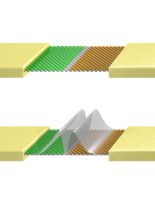A cousin of quantum tunnelling: defect supported conduction

Physiker der FAU und des Max-Planck-Instituts (MPI) in Halle konnten ein aktuelles Rätsel der Festkörperphysik auflösen
A fundamental and counter-intuitive phenomenon of quantum mechanics is the tunnelling of electrons through barriers that, classically, the electron should not penetrate. This effect is efficient only on the nanoscale, due to the exponential decay of the wave function in the barrier.
It was therefore surprising when a decade ago it was seen that in mono- or bilayer-graphene, i.e. one or two sheets of graphite, such exponential wave functions led to a long distance transport mechanism barely distinguishable from regular diffusive transport in any conductive material. Complicating this picture, however, a number of prominent recent experiments reported both highly conductive as well as highly insulating states in apparently identical samples of bilayer graphene, an unexpected result that challenged theoretical physics. While exotic quantum phases of matter have been proposed, these explain only insulating part of the data.
Theory of electronic transport in bilayers with defects
While the intense research on this topic worldwide focuses on electron transport assuming a perfect material FAU researchers Shallcross and Weber, supported S. Sharma (Max Planck Halle), created a theory of transport for imperfect bilayers including ripple like stacking faults recently discovered by FAU researchers. For this purpose a novel theoretical tool to describe electronic states in low dimensional matter was created. Its application to the bilayer problem revealed a novel type of electron transport that shares the mathematical description with tunnelling. Counterintuitively, adding defects to the bilayer stabilizes a long range structure of the wave function, with the ripples acting as “pegs” on which the exponential wave functions can be supported.
To their own surprise, Shallcross, Sharma, and Weber found that this wave function structure allows for both highly insulating and highly conductive transport in the bilayer. This comprehensively explains the full phenomenology of transport in bilayer graphene without the need for exotic quantum ground states.
This concept can be applied to many members of the important emerging class of 2d materials, of which bilayer graphene is the best known prototype. It provides another important example of the fundamental differences that exist between charge transport in two dimensions and the familiar world of three dimensions.
The work was carried out as a joint project within the SFB 953, „Synthetic carbon allotropes”. This open access paper was published in the highly ranked journal “Nature Communications“.
Further information:
